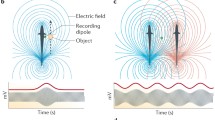Summary
The responses of single neurons to visual and electrosensory stimulation were studied in the optic tectum of the weakly electric fishApteronotus albifrons. Most of the cells recorded in the region of the tectum studied, the anterior medial quadrant, were poorly responsive or completely insensitive to flashes of light or to bursts of AC electrical stimuli applied to the entire fish. However, these cells gave vigorous responses to moving visual or electrosensory stimuli. Most cells showed differences in their response contingent upon the direction of the stimulus movement and most received input from both the visual and electrosensory systems. Electrosensory responses to moving stimuli were depressed by jamming stimuli, 4 Hz amplitude modulation of the animal's electric organ discharge, presented simultaneously with the moving stimulus. However, the jamming signal presented alone typically evoked no response. Moving visual stimuli, presented simultaneously with the electrosensory, were usually able to restore the magnitude of a response toward its value in the unjammed situation. For most of the cells studied the receptive fields for vision and electroreception were in register. In some cases the visual and electrosensory components could be separated by presenting the two types of stimuli separately, or by presenting both simultaneously but with some amount of spatial separation, which causes the two to be misaligned relative to the fish. In other cases the individual responses could not be separated by spatial manipulations of the two stimuli and in these cases differences in the alignment of the two types of stimuli could cause changes in the intensity of the cells' responses.
Similar content being viewed by others
Abbreviations
- AM :
-
amplitude modulation
- EOD :
-
electric organ discharge
- PLLL :
-
posterior lateral line lobe
References
Bastian J (1976) The range of electrolocation: A comparison of electroreceptor responses and the responses of cerebellar neurons in a gymnotid fish. J Comp Physiol 108:193–210
Bastian J (1981a) Electrolocation. I. How the electroreceptors ofApteronotus albifrons code for moving objects and other electrical stimuli. J Comp Physiol 144:465–479
Bastian J (1981b) Electrolocation. II. The effects of moving objects and other electrical stimuli on the activities of two categories of posterior lateral line lobe cells inApteronotus albifrons. J Comp Physiol 144:481–494
Bastian J (1981c) Visual and electrosensory responses in the optic tectum of a weakly electric fish, 11th Annual Meeting, Society for Neurosciences, Los Angeles, California, Abstr no 272-9
Bastian J, Heiligenberg W (1980) Neural correlates of the jamming avoidance response ofEigenmannia. J Comp Physiol 136:113–133
Behrend K (1977) Processing information carried in a high frequency wave: Properties of cerebellar units in a high frequency electric fish. J Comp Physiol 118:357–371
Bullock TH (1982) Electroreception. Annu Rev Neurosci 5:121–170
Bullock TH, Hamstra RH, Scheich H (1972) The jamming avoidance response of high frequency electric fish. II. Quantitative aspects. J Comp Physiol 77:23–48
Carr CE, Maler L, Heiligenberg W, Sas E (1982) Laminar organization of the afferent and efferent systems of the torus semicircularis of gymnotiform fish: Morphological substrates for parallel processing in the electrosensory system. J Comp Neurol 203:649–670
Drager UC, Hubel DH (1976) Topography of visual and somatosensory projections to mouse superior colliculus. J Neurophysiol 39:91–102
Enger PS, Szabo T (1965) Activity of central neurons involved in electroreception in some weakly electric fish (Gymnotoidae). J Neurophysiol 28:800–818
Hagiwara S, Szabo T, Enger PS (1965) Electroreceptor mechanisms in a high frequency weakly electric fishSternarchus albifrons. J Neurophysiol 28:784–799
Hartline P (1974) Thermoreception in snakes. In: Fessard A (ed) Handbook of sensory physiology, vol III/3. Springer, Berlin Heidelberg New York, pp 297–312
Heiligenberg W (1977) Principles of electrolocation and jamming avoidance in electric fish, a neuroethological approach. In: Braitenberg V (ed) Studies of brain function. Springer, Berlin Heidelberg New York
Heiligenberg W (1980) Jamming avoidance response inEigenmannia. A behavior controlled by distributed evaluation of electroreceptor afferences. Naturwissenschaften 67:499–547
Heiligenberg W, Baker C, Matsubara J (1978) The jamming avoidance response inEigenmannia revisited: The structure of a neuronal democracy. J Comp Physiol 127:267–286
Ingle D, Sprague JM (1977) Sensorimotor function of the midbrain tectum. In: Neuroscience research program bulletin, vol 13. MIT Press, Cambridge, Massachusetts
Matsubara JA (1981) Neural correlates of a nonjammable electrolocation system. Science 211:722–725
Newman EA, Hartline P (1981) Integration of visual and infrared information in bimodal neurons of the rattlesnake optic tectum. Science 213:789–791
O'Benar JD (1976) Electrophysiology of neural units in goldfish optic tectum. Brain Res Bull 1:529–541
Scheich H, Bullock TH (1974) The detection of electric fields from electric organs. In: Fessard A (ed) Handbook of sensory physiology, vol III/3. Springer, Berlin Heidelberg New York, pp 201–256
Scheich H (1977) Neural basis of communication in the high frequency electric fishEigenmannia virescens (jamming avoidance response). III. Central integration in the sensory pathway and control of the pacemaker. J Comp Physiol 113:207–227
Schroeder DM, Vanegas H (1977) Cytoarchitecture of the tectum mesencephali in two types of siluroid teleosts. J Comp Neurol 175:287–300
Simpson GS, Roe A, Lewontin RC (1960) Quantitative zoology. Harcourt, Brace and World, New York
Skarf B, Jones MJ (1981) Vestibular-visual interactions in frog mesencephalon during natural stimulation. Brain Res 206:457–461
Szabo T, Fessard A (1974) Physiology of electroreceptors. In: Fessard A (ed) Handbook of sensory physiology, vol III/3. Springer, Berlin Heidelberg New York, pp 59–125
Wartzok D, Marks W (1973) Directionally selective visual units recorded in optic tectum of the goldfish. J Neurophysiol 36:588–604
Author information
Authors and Affiliations
Rights and permissions
About this article
Cite this article
Bastian, J. Vision and electroreception: Integration of sensory information in the optic tectum of the weakly electric fishApteronotus albifrons . J. Comp. Physiol. 147, 287–297 (1982). https://doi.org/10.1007/BF00609662
Accepted:
Issue Date:
DOI: https://doi.org/10.1007/BF00609662




